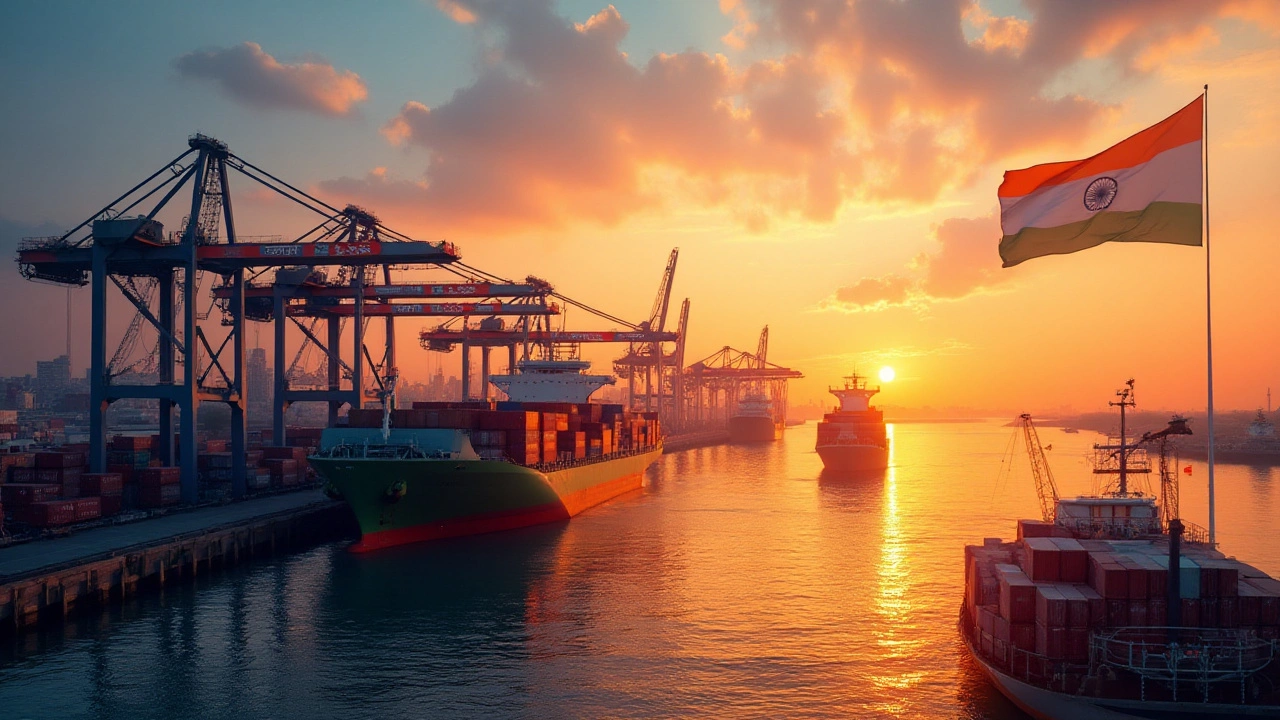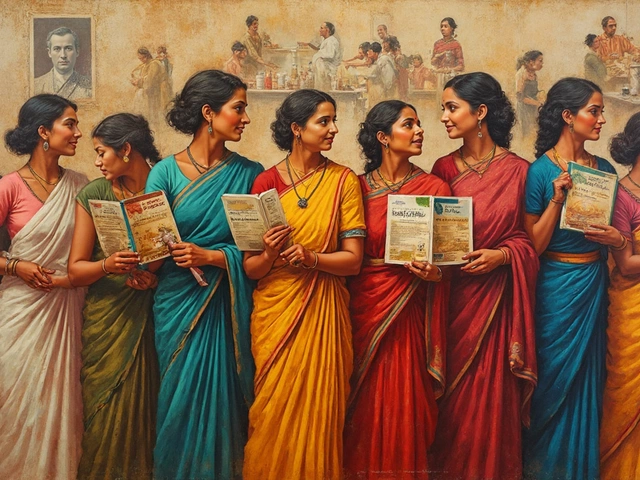Understanding India's Trade Policy in 2024: A Guide for Trade Courses
India's trade policy serves as a cornerstone for its economic strategy, influencing not just national growth but also its standing in global commerce. It's a blend of tradition and modernity, cultivated over decades and shaped by myriad challenges and victories.
This article will unravel the intricacies of India's trade approach, offering insights into its historical roots and modern developments. As the world becomes more interconnected, understanding India's trade policy is increasingly vital for those involved in trade courses or looking to dive into this dynamic field.
- Introduction to India's Trade Policy
- Historical Evolution and Current Dynamics
- Key Features of the Policy
- Impact on Trade Courses in India
- Strategic Partnerships and Global Influence
- Future Challenges and Opportunities
Introduction to India's Trade Policy
India's trade policy is a comprehensive framework designed to manage and oversee the nation's trade relations with the rest of the world. It plays a central role in the country's economic framework and is instrumental in driving growth, creating jobs, and promoting sustainable development. This policy is not just about the movement of goods and services, but it also encompasses important aspects such as foreign direct investment, bilateral trade agreements, and strategies to boost domestic industries.
The roots of India's trade policy can be traced back to the post-independence era, when the country adopted a protectionist approach to safeguard its nascent industries. Over the years, this policy evolved to embrace more liberal trade practices, especially during the economic reforms of the early 1990s. These reforms marked a significant shift as India trade policy opened up to increased foreign investment and multilateral trade agreements. This shift was vital for integrating India's economy with the global market.
One of the distinguishing features of India's trade policy today is its emphasis on export growth and diversification. The government has launched several initiatives to promote exports, including 'Make in India', which aims to transform the country into a global manufacturing hub. This is vital for creating more jobs and increasing the nation's global competitiveness. A notable quote from economist Arvind Panagariya states,
'India’s journey from a closed economy to becoming a significant player on the world stage is a testament to its robust trade policies.' This encapsulates the transformative impact of trade policy on India's economy.
Another integral component is the focus on bilateral and regional trade agreements. By entering into strategic partnerships and agreements, such as with ASEAN and countries under the Comprehensive Economic Partnership Agreements (CEPA), India seeks to enhance its trade volumes and overcome trade barriers. The nation's policy also underscores the importance of digital trade as the world increasingly shifts towards digital platforms for commerce. Embracing technology and innovation is essential for sustaining long-term growth in the Indian economy.
The elements that guide India's trade policy are embedded in its Export Import Policy (Exim Policy), which is updated periodically to reflect changing global dynamics. Key objectives include enhancing access to new markets, encouraging high-value-added exports, and improving infrastructure at ports and logistics for smoother trade operations. There's a growing emphasis on developing industry clusters to boost productivity and competitiveness.
In June 2023, Indian exports amounted to $32.25 billion, showing a steady growth trend. This figure illustrates the tangible effects of a well-structured trade policy. Balancing trade deficits, reducing dependency on a few commodities, and addressing non-tariff barriers remain challenges. However, with a strategic focus and continued re-evaluation, India's trade policy is poised to adapt and thrive in a rapidly changing global environment.
Historical Evolution and Current Dynamics
The evolution of India's trade policy is a fascinating journey through time, tracing the nation’s shift from a largely controlled economy towards one that is embracing globalization with aspirations of becoming a major trade hub. After gaining independence in 1947, India adopted a mixed economy model, emphasizing self-reliance and import substitution. During this period, stringent regulations governed trade, aimed at fostering domestic industry. The 1991 economic reforms marked a pivotal turning point, as India underwent liberalization, opening up its markets to foreign investment and global trade. These reforms dismantled tariffs and quotas that had long isolated India from the international marketplace. The liberalization set the stage for integrating into the global economy, aligning with the growing world trend towards free trade. Today, India's trade policy is dynamic, adapting to rapid changes in global trade patterns and geopolitical shifts.
India's economic transition was not just about policy changes but also about a fundamental shift in mindset. The reforms of the 1990s were characterized by reducing governmental control over various industrial sectors, which, in turn, facilitated a boom in exports. Information technology, pharmaceuticals, textiles, and automotive industries emerged as key sectors in driving the export growth. By the early 2000s, India was increasingly seen as a rising powerhouse in the international market, with a significant rise in the value of exports. According to the World Bank, India’s exports rose from approximately $18 billion in 1991 to over $250 billion by 2011. This was indicative of the enduring impact of liberalization on the country's trade landscape. Yet, challenges remain, with India needing to balance protectionism aimed at spurring local businesses and fostering robust international trade relations.
In recent years, the focus has sharply shifted towards sustainability, digitalization, and strategic partnerships. India is aggressively pursuing trade agreements that reflect its ambitions and strategic interests on a global scale. These alliances aim to enhance market access and technological exchange with partners across Asia, Europe, and North America. For instance, the proposed Free Trade Agreement with the European Union signifies India's commitment to solidifying trade ties with key economic regions. As the nation positions itself as a vanguard of innovation and growth, India's policy reflects an agile approach to adapting to changing global economic dynamics and digital advancements. Remarkably, a report by the Ministry of Commerce notes that in 2023, India achieved a record export of $422 billion, showcasing resilience in its trade despite global supply chain disruptions.
"India's trade future rests not merely in the intricate balance of tariffs and treaties, but in cultivating partnerships that reflect mutual economic aspirations and sustainable growth," remarked Arvind Subramanian, a renowned economist and former Chief Economic Advisor to India.As global trade becomes increasingly competitive, India is significantly investing in infrastructure to boost connectivity and reduce logistical bottlenecks, seen through initiatives like 'Sagarmala' and 'Make in India'. This focus on economic zones and modernization of transport routes is crucial to India's strategy to enhance its export capabilities and integrate better with international supply chains.
Looking ahead, India faces the challenge of harnessing technological innovation while addressing socio-economic disparities. Keeping a close tab on e-commerce trends and how digital transactions are redefining trade, Indian policymakers are working on frameworks to better integrate these novel modes of business within its trade laws. The technological shift also requires upgrading workforce skills, making trade-centric courses critical not only to economic policies but also to educational strategies. As India marches forward, its trade policy continues to evolve, reflecting both internal ambitions and the need to play a pivotal role on the world stage.

Key Features of the Policy
India's trade policy is a complex tapestry woven from its historical trade practices, geographic advantages, and the need to align with global markets. At its core, this policy is structured to enhance India's trade competitiveness while ensuring that domestic industries remain shielded from erratic global changes. One of the primary facets is the emphasis on bilateral and multilateral trade agreements which India engages in to secure preferential access to vital markets. These agreements, often painstakingly negotiated, are designed to bolster India's global trade footprint while ensuring that Indian businesses have the necessary support and opportunities to thrive.
Another prominent feature is the robust framework for export promotion. India identifies key sectors with high growth potential such as electronics, textiles, pharmaceuticals, and agribusiness, providing incentives and subsidies to boost exports. The government has established Special Economic Zones (SEZs) to attract foreign direct investment and enhance production and export capacities. This policy also incorporates a strategic push for 'Make in India', which encourages foreign and domestic companies to manufacture within the country, fostering economic growth and self-reliance.
Strategic Policy Instruments
The policy utilizes various instruments to regulate imports including tariffs, quotas, and non-tariff barriers. By imposing these, India aims to protect emerging industries from premature exposure to fierce international competition. The strategy actively supports small and medium enterprises (SMEs), an essential backbone for the Indian economy, through tailored financial aid and access to cutting-edge technology and markets. Here's where the importance of regulatory bodies such as the Directorate General of Foreign Trade (DGFT) comes into play, ensuring that policies are not only formulated but also effectively implemented.
The Economist once highlighted, "India’s trade strategy must balance protecting its industries with integrating into the global economy, a feat that requires both deft policy-making and execution."
Adaptation and Reforms
Adapting to the changing global trade environment, the Indian government frequently revisits its policies, introducing necessary reforms to keep pace. These include digital innovations to simplify trade operations, improved logistics and infrastructure, and initiatives to reduce bureaucratic red tape. According to a 2024 report, India's exports have seen a significant increase after implementing these changes, reflecting the positive impact of these initiatives. Additionally, the policy aims to enhance trade relationships with emerging markets while maintaining strong ties with traditional partners, ensuring diversification and risk management in its trade relations.
India trade policy is constantly evolving, driven by a vision to position the country as a major economic player on the world stage. These features are not static but dynamic, reflecting the country's adaptability and resilient approach to the global economy. Through educational programs and trade courses, understanding these key features can be greatly beneficial for professionals and students looking to navigate or specialize in this ever-evolving field.
Impact on Trade Courses in India
The evolution of India's trade policy has significantly influenced educational programs nationwide, especially trade courses. As India becomes an increasingly critical player in global trade, academic institutions have adapted their curriculums to reflect these changes. Students now find themselves immersed in modules focusing on global market dynamics, export-import regulations, and strategic economic policies.
One major shift is the emphasis on practical knowledge alongside theoretical grounding. Institutions are partnering with industries to offer internships that provide hands-on experience, ensuring students don't just learn behind desks but engage with real-world trade environments. This approach prepares them for the complexities of professional life in the trade sector and aligns with the country's need for skilled professionals who can navigate international markets effectively.
The increase in demand for trade expertise has led universities to offer specialized courses that cover a wide array of topics from Indian economy reforms to international negotiation skills. In many leading universities, the inclusion of case studies that highlight India's trade triumphs and failures offer invaluable insights. For instance, the role of technology in improving export logistics is becoming a key study area, addressing the challenges faced by businesses in connecting with global markets.
A report by the Ministry of Commerce and Industry notes that there has been a 20% increase in enrollments in trade-related programs over the past five years. Such growth is reflective of the increasing recognition of trade as a lucrative career field. To support this, trade courses have expanded to include modules on emerging markets and strategies for entering them, considering India's strategic partnerships and alliances as case studies.
Special focus is also placed on understanding regulatory frameworks, a domain that remains constantly evolving. As trade policies are updated to keep pace with global economic changes, trade courses ensure students remain topical. They have to constantly monitor political and economic shifts that might affect trade agreements and adapt accordingly. This educational approach instills a deep understanding of both the stability and volatility of international trade relations.
Moreover, India's current policies support a bi-directional learning trend — from India to the world and vice versa. This involves understanding foreign trade policies that impact India's trade interests. Trade courses thus increasingly incorporate international faculty, guest lectures from foreign experts, and even exchange programs which enhance the educational experience by offering broader perspectives.
"Trade education is no longer just about teaching tariffs and agreements," says Professor Rajiv Kumar of IIFT. "It's about crafting global citizens who understand the nuances of international business, equipped with the skills to leverage India's growing influence in world markets."

Strategic Partnerships and Global Influence
In its quest to fortify its position in the international arena, India has forged a number of strategic partnerships over the years. These alliances are not merely transactional; they are deeply rooted in fostering economic growth and geopolitical stability. A significant player in Asian economics, India has extensively collaborated with neighboring countries like Japan and China, despite occasional diplomatic tussles. Japan has been a long-standing partner in sectors like infrastructure and technology, with initiatives such as the Delhi-Mumbai Industrial Corridor showcasing the depth of their cooperation. Meanwhile, India's relationship with China, albeit complex, involves substantial trade, though it is often shrouded in a veil of competitive tension.
Beyond Asia, India's strategic dialogues with the United States and the European Union have substantially increased over the past decade. The economic ties with the US have been cemented through initiatives such as the US-India Strategic Partnership Forum, which boosts bilateral trade and investment considerably. Recently, data showed that bilateral trade between these two nations reached an impressive $191 billion in 2023, emphasizing the pivotal role America plays in India's economic landscape. With the EU, India's agreements not only focus on economic elements but also cover environmental challenges and sustainable development, making it a comprehensive and multidimensional relationship. This engagement has led to increased market access for Indian products and enhanced collaboration in sectors like technology and research.
India's strategic focus also extends to Africa, where it has emerged as a key development partner. The India-Africa Forum Summits are testaments to this growing bond, anchoring India's influence in African economics and human resource development. These alliances have also strengthened trade ties, with Indian investments providing a boost to sectors such as healthcare, mining, and telecommunications in various African nations. Moreover, the Indian Ocean region remains a critical aspect of India's strategic thinking, given its significance for maritime trade routes. By collaborating on initiatives like SAGAR (Security and Growth for All in the Region), India aims to ensure maritime security and cooperation with island countries and nations along this vital corridor.
Global trade dynamics being what they are, India's trade policy emphasizes building bilateral regional trade agreements to enhance its influence in global markets. In recent years, trade agreements with emerging economies like Brazil and South Africa reflect India's strategy of diversifying its trade partnerships. Such deals are crucial for India in tapping into emerging markets and reducing dependency on traditional trade partners. The pursuit of these varied strategic alliances underlines a crucial facet of India's trade policy—flexibility and adaptability to changing geopolitical landscapes.
According to a study by the Centre for Strategic and International Studies, "India's role in global trade is increasingly pivotal, not just as a market but as an integral supplier in the supply chain matrix." This insight underscores the necessity of maintaining and nurturing these strategic alliances. India's emphasis on creating a robust network with countries around the globe reflects not just its ambitions but its recognition of evolving global interdependencies. As a nation eager to play a central role in world trade, sustaining these strategic partnerships will continue to be a cornerstone of India's trade policy.
In the realm of trade courses, understanding India's intricate web of strategic partnerships offers students and professionals a unique perspective on international trade dynamics. Analyzing these relationships not only highlights the nuances of economic diplomacy but also provides insights into how these alliances can be harnessed for mutual benefit. For those involved in trade education, these alliances present a rich tapestry from which valuable lessons can be drawn, offering a glimpse into how nations navigate the complex waters of global commerce.
Future Challenges and Opportunities
Examining the India trade policy in the coming years, two key elements emerge as both challenges and opportunities: technology integration and environmental sustainability. India stands at a crossroads where embracing digital advancements can bolster its trade efficiency. Investing in technology-driven processes like e-commerce and blockchain provides avenues for enhancing trade transparency and reducing transaction times. For trade courses in India, this means a curriculum that integrates technology-oriented modules, preparing students for a digitized trade environment. This forward-thinking approach could play a pivotal role in attracting global investors eyeing Indian economy potential.
The environmental facet of India's trade policy is equally crucial. As global attention shifts towards sustainable practices, India must tackle the challenge of aligning its trade systems with eco-friendly regulations. This shift opens pathways for new markets in green technology and renewable energy products. For students and professionals engaged in trade courses, understanding these eco-aligned policies is imperative. As discussions at major climate forums indicate, balancing economic growth with environmental stewardship will significantly influence India's standing in global trade. According to a report by the International Trade Centre, "Nurturing green trade policies is not just an ethical choice but a competitive advantage in the evolving trade landscape."
Furthermore, India's geopolitical position presents unique challenges and opportunities. Navigating international relations and fostering strategic partnerships remains complex, yet ripe with potential. Policies fostering regional trade agreements could potentially cushion India against global trade uncertainty. With the changing dynamics in global power structures, India's role as a key player can be strengthened by diversifying its trade portfolio. Trade courses must now include strategic planning and international business negotiations to reflect these realities. Thus, equipping the next generation with skills to leverage India's geopolitical advantages while addressing its vulnerabilities will be crucial.
Finally, demographic shifts and internal socio-economic challenges also shape India's trade policies. As the population grows and urbanization accelerates, domestic demands will evolve. This presents a dual challenge of satisfying national markets while maintaining export competitiveness. Strategies focusing on quality control, innovation, and consumer needs will dictate success. Importantly, these strategies need to be taught in trade courses, ensuring graduates are ready to innovate and lead. In summary, India's trade future hinges on adapting to technological, environmental, and socio-economic changes, each carrying its own set of challenges and opportunities, but all vital for sustaining India's economic growth.





